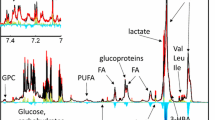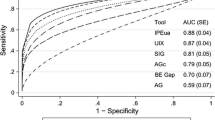Summary
Objective
Hypoxic hepatitis is a common cause of hepatic impairment in critically ill patients and is an independent risk factor for mortality. An elevated level of unmeasured anions is another unfavourable prognostic marker in many disease entities. While the biochemical nature of unmeasured anions is unknown, data suggest that they may be released from the liver. Therefore, the purpose of this study was to determine whether the strong ion gap—the gold standard for estimation of unmeasured anions—is elevated and associated with outcome in patients with hypoxic hepatitis.
Methods
One hundred and five consecutive patients with hypoxic hepatitis admitted to the (intensive care unit) ICU of a university hospital were prospectively included in the study and compared with 15 healthy controls.
Results
Compared with the controls, patients with hypoxic hepatitis had an elevated strong ion gap (4.0 ± 2.6 vs. 7.8 ± 4.0 mmol/L; p = 0.0002) that contributed to metabolic acidosis. Patients dying within 5 days had a larger strong ion gap upon admission than did patients surviving beyond 5 days. The mean strong ion gap (SIG) over the course of the first 5 days after admission to the ICU was 1.3 mmol/L (0.3–2.3 mmol/L) larger in patients who died compared with patients who survived, p = 0.008. In multivariate Cox-regression, larger strong ion gaps were associated with shorter survival time. The SIG correlated positively with both AST and ALT.
Conclusions
Unmeasured anions are elevated in patients with hypoxic hepatitis, contribute to metabolic acidosis and are associated with mortality. The liver is a possible source of the unmeasured anions, which may represent markers of tissue damage in hypoxic hepatitis.
Zusammenfassung
Ziel der Studie
Die hypoxische Hepatitis ist bei kritisch kranken Patienten eine häufige Ursache einer Leberschädigung und geht mit einer erhöhten Mortalität einher. Hohe Plasmaspiegel ungemessener Anionen sind ein ungünstiger Prognosefaktor bei verschiedenen Erkrankungen. Obgleich die (biochemische) Identität dieser Anionen nicht bekannt ist, wird die Leber als Ursprungsort vermutet. Das Ziel dieser Studie war es, zu untersuchen, ob bei Patienten mit hypoxischer Hepatits die „Starke Ionen Lücke“ (SIG) – der Goldstandard zur Bestimmung ungemessener Anionen – erhöht ist und mit dem Ausgang der Erkrankung korreliert.
Methodik
Einhundertfünf konsekutive auf die Intensivstation eines Universitätskrankenhauses aufgenommene Patienten mit hypoxischer Hepatitis wurden prospektiv in die Studie eingeschlossen und mit 15 gesunden Kontrollen verglichen.
Ergebnisse
Im Vergleich zu den Kontrollen hatten Patienten mit hypoxischer Hepatitis eine erhöhte SIG (4,0 ± 2,6 vs. 7,8 ± 4,0 mmol/L; p = 0,0002), welche zur metabolischen Azidose beitrug. Patienten, die innerhalb der ersten fünf Tage verstarben, hatten bei Aufnahme eine höhere SIG als Patienten, die diesen Zeitraum überlebten. Bei Patienten, die verstarben, war die mittlere SIG über den Zeitraum der ersten fünf Tage nach Aufnahme war um 1,3 mmol/L (0,3–2,3 mmol/L) höher als bei Patienten, die überlebten (p = 0,008). In der multivariaten Cox-Regression, war eine erhöhte SIG mit einer kürzeren Überlebenszeit assoziiert. Die SIG korrelierte positiv mit AST und ALT.
Schlussfolgerungen
Ungemessene Anionen sind bei Patienten mit hypoxischer Hepatitis erhöht, tragen zur metabolischen Azidose bei, und sind mit einer erhöhten Mortalität assoziiert. Die Leber ist ein möglicher Ursprung ungemessener Anionen, welche in Patienten mit hypoxischer Hepatitis als Marker des Gewebeuntergangs betrachtet werden können.

Similar content being viewed by others
References
Fuhrmann V, Kneidinger N, Herkner H, Heinz G, Nikfardjam M, Bojic A, et al. Impact of hypoxic hepatitis on mortality in the intensive care unit. Intensive Care Med. 2011;37:1302–10.
Fuhrmann V, Kneidinger N, Herkner H, Heinz G, Nikfardjam M, Bojic A, et al. Hypoxic hepatitis: underlying conditions and risk factors for mortality in critically ill patients. Intensive Care Med. 2009;35:1397–405.
Henrion J, Minette P, Colin L, Schapira M, Delannoy A, Heller FR. Hypoxic hepatitis caused by acute exacerbation of chronic respiratory failure: a case-controlled, hemodynamic study of 17 consecutive cases. Hepatology. 1999;29:427–33.
Henrion J, Schapira M, Luwaert R, Colin L, Delannoy A, Heller FR. Hypoxic hepatitis: clinical and hemodynamic study in 142 consecutive cases. Medicine. (Baltimore) 2003;82:392–406.
Seeto RK, Fenn B, Rockey DC. Ischemic hepatitis: clinical presentation and pathogenesis. Am J Med. 2000;109:109–13.
Funk GC, Doberer D, Kneidinger N, Lindner G, Holzinger U, Schneeweiss B. Acid–base disturbances in critically ill patients with cirrhosis. Liver Int. 2007;27:901–9.
Naka T, Bellomo R, Morimatsu H, Rocktaschel J, Wan L, Gow P, et al. Acid–base balance in combined severe hepatic and renal failure: a quantitative analysis. Int J Artif Organs. 2008;31:288–94.
Funk GC, Doberer D, Fuhrmann V, Holzinger U, Kitzberger R, Kneidinger N, et al. The acidifying effect of lactate is neutralized by the alkalinizing effect of hypoalbuminemia in non-paracetamol-induced acute liver failure. J Hepatol. 2006;45:387–92.
Kaplan LJ, Kellum JA. Initial pH, base deficit, lactate, anion gap, strong ion difference, and strong ion gap predict outcome from major vascular injury. Crit Care Med. 2004;32:1120–4.
Dondorp AM, Chau TT, Phu NH, Mai NT, Loc PP, Chuong LV, et al. Unidentified acids of strong prognostic significance in severe malaria. Crit Care Med. 2004;32:1683–8.
Funk GC, Doberer D, Sterz F, Richling N, Kneidinger N, Lindner G, et al. The strong ion gap and outcome after cardiac arrest in patients treated with therapeutic hypothermia: a retrospective study. Intensive Care Med. 2009;35:232–9.
Kellum JA, Bellomo R, Kramer DJ, Pinsky MR. Hepatic anion flux during acute endotoxemia. J Appl Physiol. 1995;78:2212–7.
Fuhrmann V, Madl C, Mueller C, Holzinger U, Kitzberger R, Funk GC, et al. Hepatopulmonary syndrome in patients with hypoxic hepatitis. Gastroenterology. 2006;131:69–75.
Le Gall JR, Lemeshow S, Saulnier F. A new Simplified Acute Physiology Score (SAPS II) based on a European/North American multicenter study. JAMA. 1993;270:2957–63.
Gibson PR, Dudley FJ. Ischemic hepatitis: clinical features, diagnosis and prognosis. Aust N Z J Med. 1984;14:822–5.
Hickman PE, Potter JM. Mortality associated with ischaemic hepatitis. Aust N Z J Med. 1990;20:32–4.
Siggaard-Andersen O, Wimberley PD, Fogh-Andersen N, Gothgen IH. Measured and derived quantities with modern pH and blood gas equipment: calculation algorithms with 54 equations. Scand J Clin Lab Invest. 1988;48(Suppl. 189):7–15.
Stewart PA. Modern quantitative acid–base chemistry. Can J Physiol Pharmacol. 1983;61:1444–61.
Figge J, Mydosh T, Fencl V. Serum proteins and acid–base equilibria: a follow-up. J Lab Clin Med. 1992;120:713–19.
Kellum JA. Closing the gap on unmeasured anions. Crit Care. 2003;7:219–20.
Gilfix BM, Bique M, Magder S. A physical chemical approach to the analysis of acid–base balance in the clinical setting. J Crit Care. 1993;8:187–97.
Bland JM, Altman DG. Statistical methods for assessing agreement between two methods of clinical measurement. Lancet. 1986;1:307–10.
Forni LG, McKinnon W, Lord GA, Treacher DF, Peron JM, Hilton PJ. Circulating anions usually associated with the Krebs cycle in patients with metabolic acidosis. Crit Care. 2005;9:591–5.
Kneidinger N, Lindner G, Fuhrmann V, Doberer D, Dunkler D, Schneeweiss B, et al. Acute phase proteins do not account for unmeasured anions in critical illness. Eur J Clin Invest. 2007;37:820–5.
Bruegger D, Kemming GI, Jacob M, Meisner FG, Wojtczyk CJ, Packert KB, et al. Causes of metabolic acidosis in canine hemorrhagic shock: role of unmeasured ions. Crit Care. 2007;11:R130.
Moviat M, Terpstra AM, Ruitenbeek W, Kluijtmans LA, Pickkers P, van der Hoeven JG. Contribution of various metabolites to the “unmeasured” anions in critically ill patients with metabolic acidosis. Crit Care Med. 2008;36:752–8.
Murray D, Grant D, Murali N, Butt W. Unmeasured anions in children after cardiac surgery. J Thorac Cardiovasc Surg. 2007;133:235–40.
Kellum JA, Bellomo R, Kramer DJ, Pinsky MR. Splanchnic buffering of metabolic acid during early endotoxemia. J Crit Care. 1997;12:7–12.
Henrion J, Descamps O, Luwaert R, Schapira M, Parfonry A, Heller F. Hypoxic hepatitis in patients with cardiac failure: incidence in a coronary care unit and measurement of hepatic blood flow. J Hepatol. 1994;21:696–703.
Kneidinger N, Fuhrmann V, Kitzberger R, Wraszawska J, Holzinger U, Lindner G, et al. Assessment of liver function in patients with hypoxic hepatitis by indocyanine green clearance. Intensive Care Med. 2007;33(Suppl. 2)52.
Khosravani H, Shahpori R, Stelfox HT, Kirkpatrick AW, Laupland KB. Occurrence and adverse effect on outcome of hyperlactatemia in the critically ill. Crit Care. 2009;13:R90.
Rivers E, Nguyen B, Havstad S, Ressler J, Muzzin A, Knoblich B, et al. Early goal-directed therapy in the treatment of severe sepsis and septic shock. N Engl J Med. 2001;345:1368–77.
Kumar A, Roberts D, Wood KE, Light B, Parrillo JE, Sharma S, et al. Duration of hypotension before initiation of effective antimicrobial therapy is the critical determinant of survival in human septic shock. Crit Care Med. 2006;34:1589–96.
Conflict of interest
The authors who have taken part in this study declared that they do not have anything to disclose regarding funding or conflict of interest with respect to this manuscript.
Author information
Authors and Affiliations
Corresponding author
Rights and permissions
About this article
Cite this article
Kneidinger, N., Funk, GC., Lindner, G. et al. Unmeasured anions are associated with short-term mortality in patients with hypoxic hepatitis. Wien Klin Wochenschr 125, 474–480 (2013). https://doi.org/10.1007/s00508-013-0400-9
Received:
Accepted:
Published:
Issue Date:
DOI: https://doi.org/10.1007/s00508-013-0400-9




